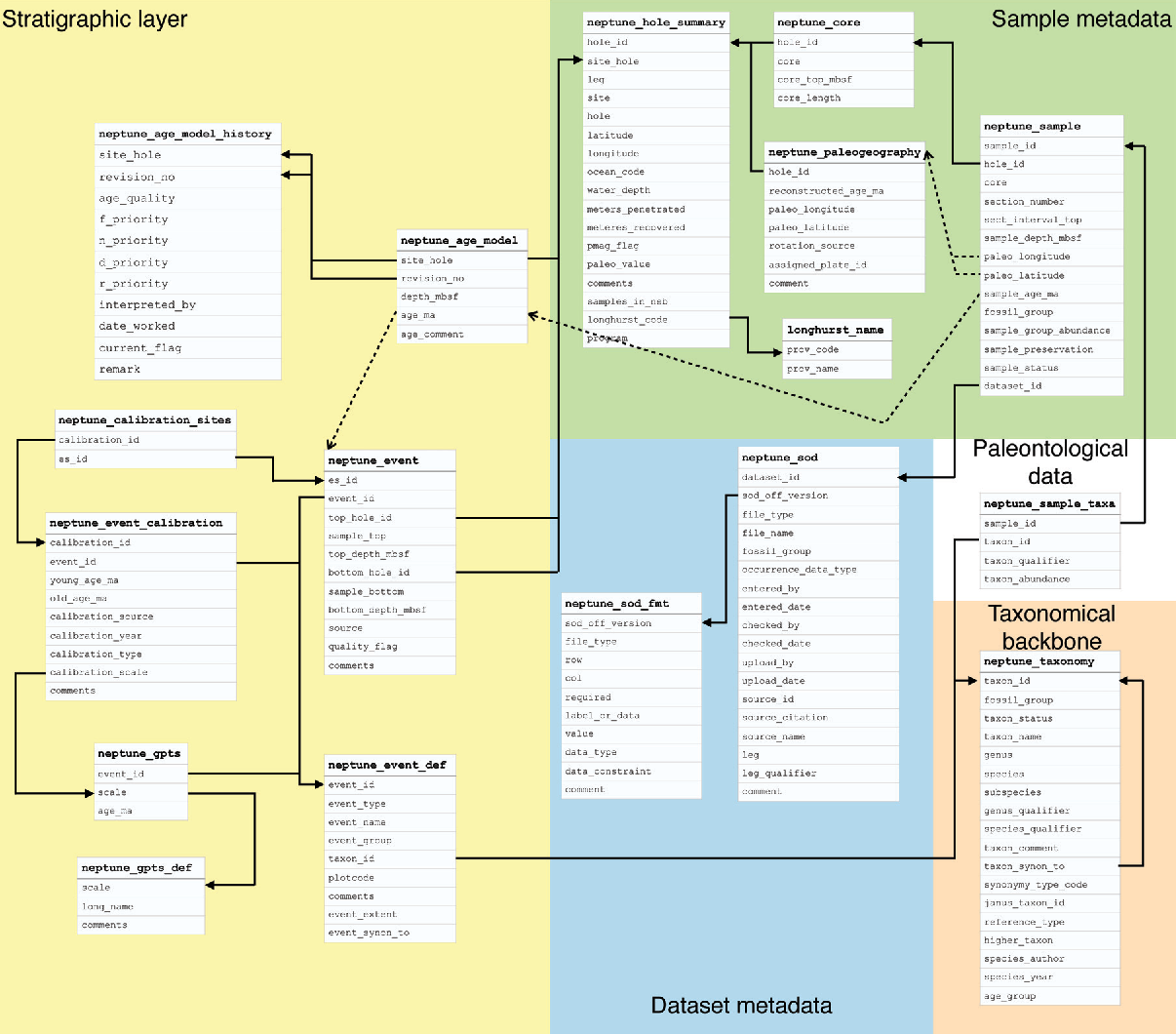
This graph illustrates the architecture of the NSB relational database: the taxonomic lists of different species provides the backbone, and is related in turn to the paleontological data, the metadata about sample and dataset, and data on the stratigraphic layer. This allows us to visualise the connections between data that constitute the database and make it a useful tool beyond micropaleontology.1
The Neptune Sandbox Berlin database is the current implementation of the Neptune database,2 a digital archive and tool which holds almost a million records of microfossil species occurrences from  core samples obtained through
core samples obtained through  deep sea drilling and other sampling techniques. Hosted by the Museum für Naturkunde Berlin, the database enables easy correlation of up-to-date taxonomic lists with age models and geochronologic data. As such, it is an important tool in the study of
deep sea drilling and other sampling techniques. Hosted by the Museum für Naturkunde Berlin, the database enables easy correlation of up-to-date taxonomic lists with age models and geochronologic data. As such, it is an important tool in the study of  micropaleontological formations and other aspects of planetary dynamics. The complex history of this database started at the end of the 1980s, when the museum’s micropaleontology curator David Lazarus – back then a graduate student at the ETH Zürich – started developing a synthesis of marine microfossils data.3 Bringing together data scattered across very different samples, collections, materials, and publications, Neptune proved to be a useful tool for micropaleontologists. This early version of the database was circulated in Fortran card image format files, then CD-ROM, and became accessible online in 1993. These digital infrastructures substituted or complemented former analogue data practices and media of
micropaleontological formations and other aspects of planetary dynamics. The complex history of this database started at the end of the 1980s, when the museum’s micropaleontology curator David Lazarus – back then a graduate student at the ETH Zürich – started developing a synthesis of marine microfossils data.3 Bringing together data scattered across very different samples, collections, materials, and publications, Neptune proved to be a useful tool for micropaleontologists. This early version of the database was circulated in Fortran card image format files, then CD-ROM, and became accessible online in 1993. These digital infrastructures substituted or complemented former analogue data practices and media of  record-keeping in the museum, such as
record-keeping in the museum, such as  logbooks or
logbooks or  inventories. It was only in 2009 that the database, which had in the meantime gone through different iterations, returned under the supervision of Lazarus, who had meanwhile joined the Naturkundemuseum Berlin. Since then, the NSB has grown into a unique and important tool in the interdisciplinary study of microfossil records from deep sea drilling: updating its models, improving its digital architecture, and facilitating its circulation, the current iteration of the database reaches a broader, interdisciplinary audience and is now used beyond the community of specialists from which it originated. Together with the Museum für Naturkunde Berlin’s micropaleontology collections, including the
inventories. It was only in 2009 that the database, which had in the meantime gone through different iterations, returned under the supervision of Lazarus, who had meanwhile joined the Naturkundemuseum Berlin. Since then, the NSB has grown into a unique and important tool in the interdisciplinary study of microfossil records from deep sea drilling: updating its models, improving its digital architecture, and facilitating its circulation, the current iteration of the database reaches a broader, interdisciplinary audience and is now used beyond the community of specialists from which it originated. Together with the Museum für Naturkunde Berlin’s micropaleontology collections, including the  Lamont-Doherty Collection, and many other collections scattered around the world, the database forms a complex infrastructure that serves as the foundation of current understandings of the history of the planet Earth and its
Lamont-Doherty Collection, and many other collections scattered around the world, the database forms a complex infrastructure that serves as the foundation of current understandings of the history of the planet Earth and its  microbial worlds. As such, the NSB database is part of the
microbial worlds. As such, the NSB database is part of the  microscopic media that make microorganisms visible. It is also a crucial medium in the transformation of living organisms like
microscopic media that make microorganisms visible. It is also a crucial medium in the transformation of living organisms like  Cycladophora davisiana into scientific objects and relational data.
Cycladophora davisiana into scientific objects and relational data.
This video illustrates the work of the micropaleontology research group at the Museum für Naturkunde Berlin and shows an interview with Johan Renaudie, micropaleontologist and manager of the NSB database. The database not only collects an incredible amount of data from decades of deep sea drilling, but also allows scientists to combine different kinds of data for the study of biostratigraphy, micropaleontology as well as geology and paleoclimatology. (Video: Filippo Bertoni/MfN. All rights reserved.)
- From J. Renaudie, D. Lazarus, and P. Diver. “NSB (Neptune Sandbox Berlin): An Expanded and Improved Database of Marine Planktonic Microfossil Data and Deep-Sea Stratigraphy”. Palaeontologia Electronica 23 (2020): 1-28. https://doi.org/10.26879/1032.↩
- See https://nsb.mfn-berlin.de (03.01.2022).↩
- For a more in depth history of the database, see Renaudie, Lazarus, and Diver, 2020.↩